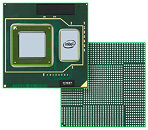- Joined
- Oct 9, 2007
- Messages
- 47,868 (7.38/day)
- Location
- Dublin, Ireland
| System Name | RBMK-1000 |
|---|---|
| Processor | AMD Ryzen 7 5700G |
| Motherboard | Gigabyte B550 AORUS Elite V2 |
| Cooling | DeepCool Gammax L240 V2 |
| Memory | 2x 16GB DDR4-3200 |
| Video Card(s) | Galax RTX 4070 Ti EX |
| Storage | Samsung 990 1TB |
| Display(s) | BenQ 1440p 60 Hz 27-inch |
| Case | Corsair Carbide 100R |
| Audio Device(s) | ASUS SupremeFX S1220A |
| Power Supply | Cooler Master MWE Gold 650W |
| Mouse | ASUS ROG Strix Impact |
| Keyboard | Gamdias Hermes E2 |
| Software | Windows 11 Pro |
With the debut of six products based on the Intel Atom processor, Intel Corporation is making it easier for customers to go-to-market with differentiated, custom-made designs. The company today announced the configurable Intel Atom processor E600C series, which features an Intel Atom E600 processor (formerly codenamed "Tunnel Creek") paired with an Altera Field Programmable Gate Array (FPGA) in a single package.
The new Intel Atom processor provides greater flexibility and faster time-to-market for customers, who can now more readily handle design changes without complicated hardware changes - helping to lower development costs. In addition, the new processor offers board space savings and better inventory control due to the single package, as well as a simplified manufacturing flow and single vendor support through Intel.

"Our customers' needs are continually evolving and they look to Intel to provide leading-edge products and technologies that will help them differentiate and compete in the markets they serve," said Doug Davis, Intel vice president, general manager, Embedded and Communications Group, Intel Corporation. "Our new configurable Atom series helps to address these customer needs and provides greater flexibility with a simplified product choice, through one vendor."
Based on Intel architecture, the Intel Atom E600C processor series provides original equipment manufacturers with the flexibility to incorporate a wide range of standard and user-defined I/O interfaces, high-speed connectivity, memory interfaces and process acceleration to meet the evolving needs of embedded device market segments.
The Atom E600C processor series comes with Intel's extended 7-year-long life-cycle manufacturing support, and industrial and commercial temperature options, which makes it ideal for market segments such as industrial machines, portable medical equipment, communications gear, vision systems, voice over Internet protocol devices, high-performance programmable logic controllers and embedded computers.
Kontron, a leading embedded computing technology solutions manufacturer, has Atom processor E600C-based prototype boards available now, with full production beginning in the second quarter of 2011.
Formerly codenamed "Stellarton," the Intel Atom processors E665CT, E645CT, E665C, and E645C are scheduled to be available within 60 days. The E625CT and E625C are on track to be available in the first quarter of 2011. Prices range from $61 to $106 in quantities of 1,000.
View at TechPowerUp Main Site
The new Intel Atom processor provides greater flexibility and faster time-to-market for customers, who can now more readily handle design changes without complicated hardware changes - helping to lower development costs. In addition, the new processor offers board space savings and better inventory control due to the single package, as well as a simplified manufacturing flow and single vendor support through Intel.

"Our customers' needs are continually evolving and they look to Intel to provide leading-edge products and technologies that will help them differentiate and compete in the markets they serve," said Doug Davis, Intel vice president, general manager, Embedded and Communications Group, Intel Corporation. "Our new configurable Atom series helps to address these customer needs and provides greater flexibility with a simplified product choice, through one vendor."
Based on Intel architecture, the Intel Atom E600C processor series provides original equipment manufacturers with the flexibility to incorporate a wide range of standard and user-defined I/O interfaces, high-speed connectivity, memory interfaces and process acceleration to meet the evolving needs of embedded device market segments.
The Atom E600C processor series comes with Intel's extended 7-year-long life-cycle manufacturing support, and industrial and commercial temperature options, which makes it ideal for market segments such as industrial machines, portable medical equipment, communications gear, vision systems, voice over Internet protocol devices, high-performance programmable logic controllers and embedded computers.
Kontron, a leading embedded computing technology solutions manufacturer, has Atom processor E600C-based prototype boards available now, with full production beginning in the second quarter of 2011.
Formerly codenamed "Stellarton," the Intel Atom processors E665CT, E645CT, E665C, and E645C are scheduled to be available within 60 days. The E625CT and E625C are on track to be available in the first quarter of 2011. Prices range from $61 to $106 in quantities of 1,000.
View at TechPowerUp Main Site
Last edited:





